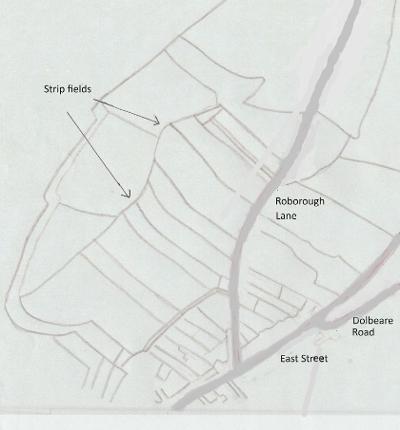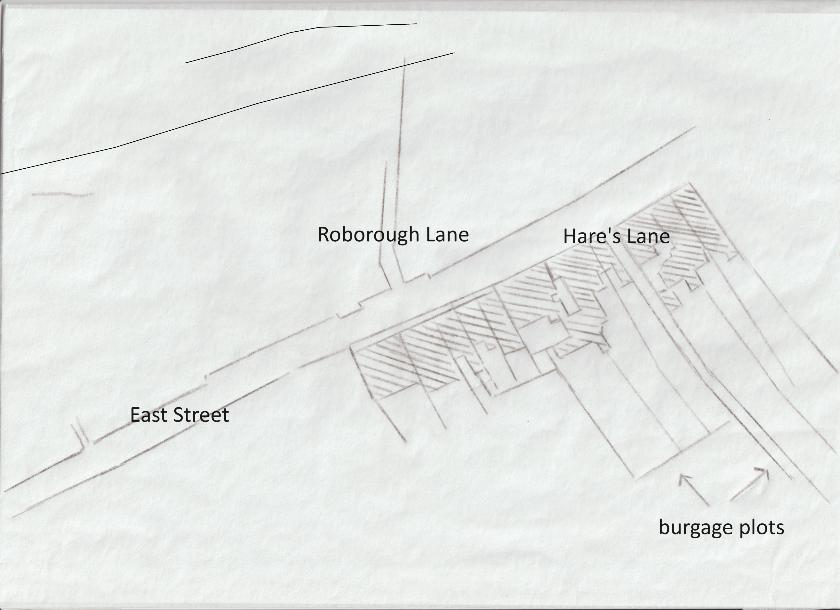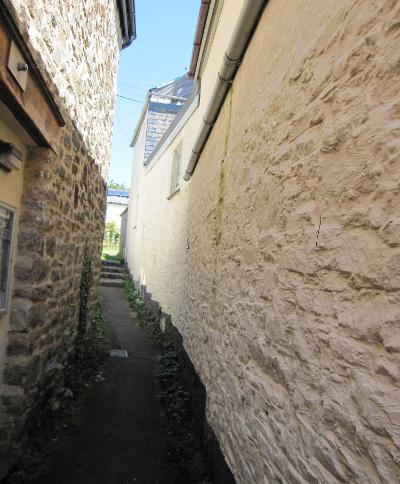* Medieval Ashburton *
The Dartmoor National Parks's conservation area character appraisal describes Ashburton as one of the county's most important medieval towns. 'The medieval layout is still clearly visible, long narrow burgage plots extending back at right angles from the principle [sic] streets.'
For more information on burgage plots see https://www.burgageplots.info/ - accessed 15-07-2-2024
Strip fields were part of the structure of the town at this time.
Dartmoor National Park Authority, 2012 https://www.dartmoor.gov.uk/__data/assets/pdf_file/0029/73379/1Ashburton-web-quality.pdf - accessed 15-07-2024

* Burgages *
Burgages were plots of land leased from a lord (or the king), with the rent being paid in cash. The burgage system was therefore distinct from the feudal system, where rent was paid through labour or agricultural services.
The land had a narrow front on to the street, which could be used for commercial purposes; behind this were often gardens and domestic premises.
Rural Historia https://ruralhistoria.com/2023/12/04/what-is-a-medieval-burgage-plot/ - accessed 18-07-2024

Above: Rough sketch of burgage plots at the top of East Street.
Burgage tenants often had the right to erect stalls or sheep pens in front of their premises. In Ashburton, those who held ancient burgages near the market claimed the right, because they had to make repairs 'of the pavements afore their several houses.'
Joan Thirsk and H P R Finberg, The Agrarian History of England and Wales, vol 4, 1500 - 1640, Cambridge University Press, 1967, p485
The tenant of a burgage had voting rights up until the parliamentary reforms of the Victorian era. However, the owners of the properties involved could put pressure on tenants to vote in the way they wished.
History of Parliament online says that there were 30 'burgage boroughs', of which Ashburton was one. ' The right to vote depended on tenancy of a specific house or other property designated as a burgage for parliamentary purposes.' There were about 100 burgages at Ashburton.
http://www.histparl.ac.uk/volume/1820-1832/survey/i-england - accessed 18-07-2024
'Ashburton. This is another burgage tenure borough, in which the tenures giving the right to vote are the property of two individuals....
... number of voters, nominally two hundred, but actually only two....
...Proprietors, Lord Clinton, and Sir Robert Palk, Bart.'
T H B Oldfield, A Complete History, Political and Personal, of the Boroughs of Great Britain, vol 3, London, 1805, p82
Historic England's listing for the corner building that encompasses 3a Stapledon Lane and 5 Foales Court notes that the premises are at the back of what would normally be thought of as a burgage plot. The front would be in North Street.
Historic England org., https://historicengland.org.uk/listing/the-list/list-entry/1201024?section=official-list-entry - accessed 18-07-2024


Above: 3a Stapledon Lane and 5 Foales Court.
Above right: About half way along Foales Court, looking up from the North Street end.
My own photographs 2024
Devon and Dartmoor HER identify 18 and 20 East Street as occupying a burgage plot. HER says the properties, possibly built as a single unit, were constructed in the latter part of the 18th century, on a burgage plot dated between 1066 and 1539.
1-2 Frome Cottages are to the rear of No. 18.
Heritage Gateway https://www.heritagegateway.org.uk/Gateway/Results_Single.aspx?uid=MDV23219&resourceID=104
68 East Street is also identified as occupying parts of two or even three burgage plots, where a medieval or post medieval house was largely superceded in the 19th century.
https://www.heritagegateway.org.uk/Gateway/Results_Single.aspx?uid=MDV62363&resourceID=104 - accessed 15-07-2024